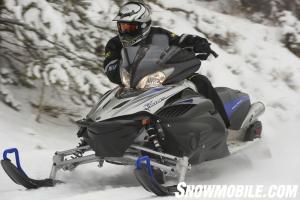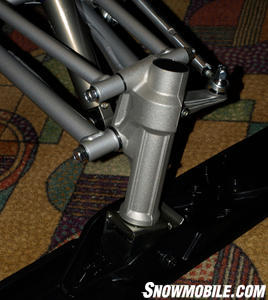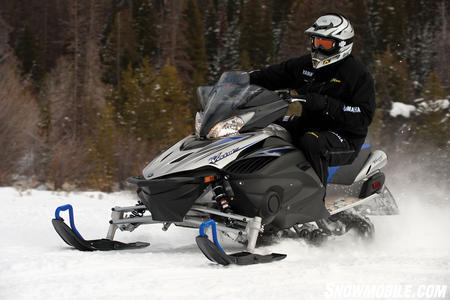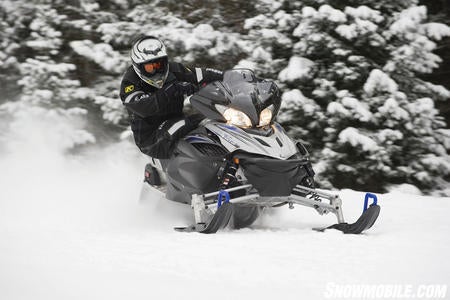2011 Yamaha RS Vector GT Review

An excellent value with four-stroke advantages
We like Yamaha’s Vector, especially its snowmobile-specific, liquid-cooled, 4-stroke triple. Fitting the Vector’s one-liter Genesis motor with electronic fuel injection gave it even better torque and overall power than the smooth-pulling carburetted predecessor. But, now Yamaha’s Apex four-cylinder with Yamaha’s “trick” EXUP exhaust and revised internal tuning is readily as “trail-able” as the Vector triple. Plus, the Apex has far superior useable power across the powerband, something we couldn’t have said before model year 2011. Up to now, the best Yamaha trail sled has been the Vector, especially so with the addition of EFI.
Engine Type:Horizontal In-line
Cylinders:3
Engine Stroke:4-Stroke
Valve Configuration:DOHC
Displacement:1049 / 64
Starter:Electric
Turbocharged:No
View Full SpecWith all the changes to the new-for-2011 Yamaha Apex, the 2011 Vector seemingly gets kicked down the pecking order as Yamaha works to promote its top of the line — in price and features — Apex. But with a US$3,000 price differential in favor of the top line Vector GT versus the base Apex, the 2011 Vector GT makes excellent sense for every day trail riders.
Our opinion is that since the 2011 Apex looks strikingly similar to the previous version, few non-Yamaha enthusiast snowmobilers will be able to tell the difference, which means the Vector holds solid value in comparison. In reality the 2011 Apex is all-new with body panels, while similar, that won’t interchange with previous year Apex models. But the 2011 Vector could probably find a fit piece or more off a pre-2011 Apex that would fit. Why you would engineer a totally new, more powerful, technically advanced version of a sled that looked so similar to the previous model leaves me foggy headed. It surely can’t help sales of the 2011 Apex, and it shouldn’t really hurt 2011 Vector sales.
 Rider forward ergonomics and curved handlebar lets riders be aggressive on tight trails.
Rider forward ergonomics and curved handlebar lets riders be aggressive on tight trails.
For the extra US$3,000, the Apex gets the technically upgraded 4-cylinder Genesis four-stroke, seriously upgraded rear suspension compete with a longer 128-inch track versus the 121-incher on the Vector, and electric power steering (EPS). You have to decide if the extra cash is worthwhile for your needs. We’d be hard-pressed if it were our dollars. We really like the EPS, but since the Vector is a cylinder shy already, the steering is nominally easier on our arms and shoulders anyway.
Since the Vector GT doesn’t get the addition of the base Apex’ torque and power, there isn’t as much need for that extra seven-inches of track length. The 130-ish horsepower from the 1,049cc triple kicks in smoothly thanks to the upgrade to 41mm fuel injection intakes from the carbs. In general, we find the Vector to be one of the best trail sleds for serious riders.
The Vector derives its pleasant on-trail personna by previous RX-1 and Apex models that preceded it and trickled down their technologies like ride-forward seating, Mono Shock rear suspension with 11.6-inches of travel and double A-arm front end. Our experiences with past Vector models caused us to rally around these Yamaha trail movers as possibly the best overall trail sled available.
 Yamaha’s A-arm front suspension delivers up to 9-inches of travel.
Yamaha’s A-arm front suspension delivers up to 9-inches of travel.
When you look past tangibles like the Genesis triple, Mono Shock suspension, trail comfort ergonomics and the myriad of features we take for granted — like the exceptionally easy to use grip heaters, contoured handlebar, quick-read fully-featured digital gauge and sleek styling — the Yamaha Vector stands out based on its intangibles. It has superior resale value. It has prime four-stroke advantages of lowered emissions, lower oil usage, lower fuel consumption when compared to an average two-stroke. There are pluses like the reliability and durabilty for which Yamaha snowmobiles are renowned. The Vector is a premium product that holds its value, provides steady every-day reliability, which should not be overlooked in a sport which measures its usage in snowy winter weekends instead of year-round usage like an ATV, UTV or motorcycle. With winter at a premium, the Vector can be counted on to give its owner maximum trail time.
We can’t say that the Vector will give you “x” mileage, because we all ride differently, but we can say unequivocally that the Genesis triple will maximize each gallon of regular unleaded fuel it uses. It’s up to you to control the throttle opening for optimum mileage.
We like the Vector for its good all-around Mono Shock II RA rear suspension with tunnel-mounted remote adjustment. Essentially, you experiment a bit, find the best setting and leave it. The remote adjuster works on the Mono Shock II RA’s 46mm KYB gas-charged shock. The front suspension features Yamaha’s GYTR dual clicker gas shocks. You can fiddle away with the clickers to set the front end for stiff or soft ride preferences.
The base Apex for 2011 has a front suspension fitted with 40mm gas shocks and a premium high pressure gas shock in the Mono Shock II RA 128 skid.
The 2011 Vector GT comes standard with the Camoplast/Yamaha derived Rip Saw that measures 15-inches across and 121-inches in overall circumference. This has been fairly standard fare for recent Vectors, right down to the 1.25-inch lug profile for gripping out of turns.
The Vector’s braking has been very consistent thanks to Yamaha’s use of a 4-piston hydraulic gripper that grabs a lightweight, ventilated disc.
If you were to compare the Vector GT’s vital statistics versus the new-for-2011 base Apex, you’d note serious change as the Vector has a 9.4-US Gallon fuel tanks, two-tenths of a gallon larger than the Apex. The Vector measures a bit more than three inches shorter, but the GT’s ski stance is slightly wider at 43.0 inches versus 42.7 inches for the Apex.
As with past Vectors, the 2011 Vector GT features key-starting and a mechanical reverse gear. For 2011 the Vector GT is available in silver with blue.
With a cost-savings of US$3,000 versus the base Apex, we could live easily with the Vector GT, but we do think, at the very least, you should test ride the latest Apex to get a feel for the new power and the ease of the power steering. Then you can make your best decision.
| 2011 Yamaha Vector GT Specs | |
| Engine | Yamaha 4-stroke Genesis 1049cc; bore/stroke of 82.0mm/66.2mm; three-cylinder, liquid-cooled; 41mm electronic fuel injection |
| Horsepower | 125+ |
| Drive | Yamaha YVXC drive clutch with Yamaha driven |
| Front Suspension | Yamaha A-arm with 40mm GYTR HPG shocks and up to 9.0-in of travel |
| Rear Suspension | Yamaha MonoShock II RA parallel slide rail with 46mm KYB gas shock with remote adjuster shock; up to 11.6-inches of travel |
| Length | 108.5 in |
| Height | 45.7 in |
| Ski Stance | 43.0 in |
| Track | 15 x 121 x 1.25 Rip Saw |
| Weight | N/A |
| Fuel Capacity | 9.4 US Gal (Regular fuel) |
| MSRP | US$10,799 |
Related Reading
2011 Yamaha Apex SE Review
2011 Yamaha Snowmobile Lineup Preview
Yamaha Unveils Electronic Power Steering
2010 Yamaha Vector GT FI Review
2010 Yamaha Vector LTX GT Review
All Things Yamaha no Snowmobile.com










 Your Privacy Choices
Your Privacy Choices